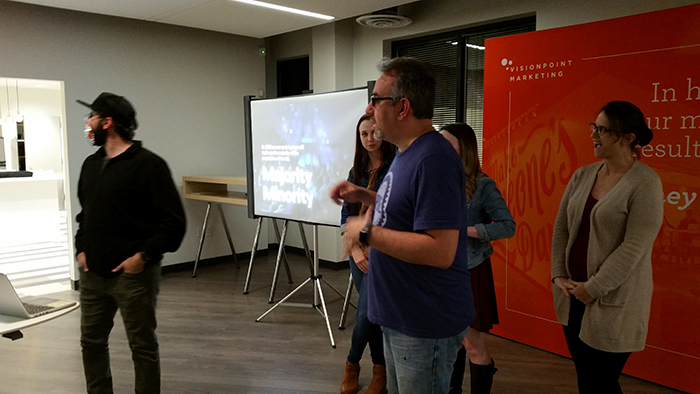Our November community meeting focused on the impact of design for our changing population. As the population changes and grows in our community and the country, it’s important to ask ourselves how design will reflect and solve problems for new audiences. As designers, we constantly solve problems beyond ourselves and learn through other perspectives. This challenge will become even more central and critical as our population becomes more diverse.
Part 1: Discussion about population trends
Director of Design Impact Niki Litts displayed two key population statistics and engaged the group in a discussion around what they mean for the future of design.
In 2055, the population aged 65+ will increase from 50 million to 90 million. What will this mean for the future of design?
A few responses from the crowd:
- A focus on accessibility standards, like screen size and font size.
- Improved design for healthcare resources
- What will it be like designing for ourselves at that age? Will be more adaptable to new technology than our grandparents?
- How will we maintain creativity while designing within accessibility constraints?
- How will technology, such as software development and machine learning, adjust along with design?
- How will we stay competitive with younger designers?
In 2050, no one racial group will make up the majority of the U.S. population. Hispanics are the fastest growing population in the U.S. How will this influence what we design, how we design and who is designing it?
A few responses from the crowd:
- More inclusive stock photography
- Hiring more diverse designers
- More diverse ways of approaching branding
- Will it make our relationships more personal to be exposed to different types of people?
- It’s an opportunity for design to be part of that changing culture
- How can we design for and represent everyone?
Niki wrapped up the conversation with these words: if you have privilege, you have the responsibility to life someone else up.
Part 2: Designing for a fictional world
We split up into groups of five to practice designing for a population we’ve never designed for. We were tasked with imagining a fictional world—from any time period, any culture, and any location—and creating a product for that world.
What type of world are you creating?
Our team created a non-violent ancient city (with modern plumbing, of course) on Pangea called Gaia. Other teams imagining a world in the sky, a world with no color, a world ruled by emotions, a hawaiian island, and a magical resource-depleted desert.

Create a product for your world around three constraints.
Our constraints:
- Requires touch
- No traditional screen or device
- Must involve a specialized or unique skill
Our product:
We prototyped Skillship Bracelets, interactive bracelets that let you transfer unique and specialized skills to anyone within arms reach. Other prototypes included a universal translator device, a gas powered water pump, a homeostasis bubble, and emotion sharing system and a clean drinking water instrument.
This activity helped us think beyond the audiences we usually design for and create a user-centered solution for a population we’ve never lived in or been exposed to. By bringing a playful tone to our earlier discussion, we were reminded that all design begins with a user. As our population changes, it’s important for design to change with it.
Part 3: Events
Check out other chapter and community events coming up:
Failure Forum and Workshop
When: Nov. 19, 9-11:30 a.m.
Where: New Kind
Homegrown: Web Accessibility for Everyone with Alisa Herr
When: Nov. 14, 11:30-1 p.m.
Where: Cantina 18
Thrive
“A conference where design thrives for everyone”
When: Feb 23, 2018, 12-6 p.m.
Where: Church on Morgan
Tickets available week of Nov. 13
Triangle Designers Slack group
Join today to be part of a larger design community!